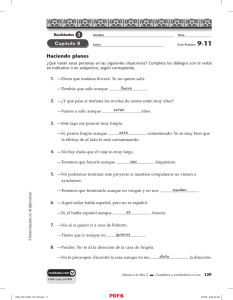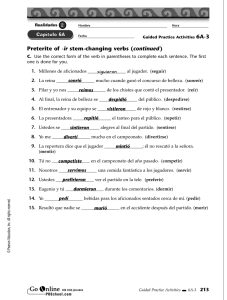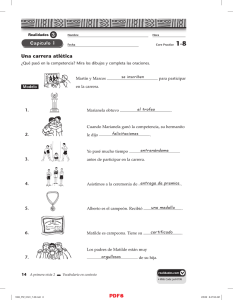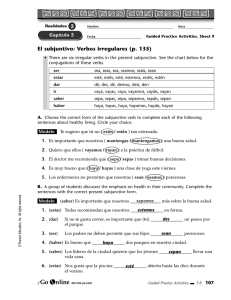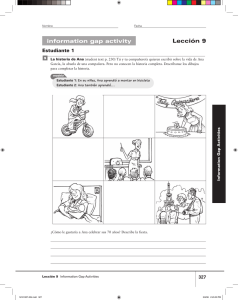Concordancia y comparación de adjetivos (p. 63) sencillas
Anuncio
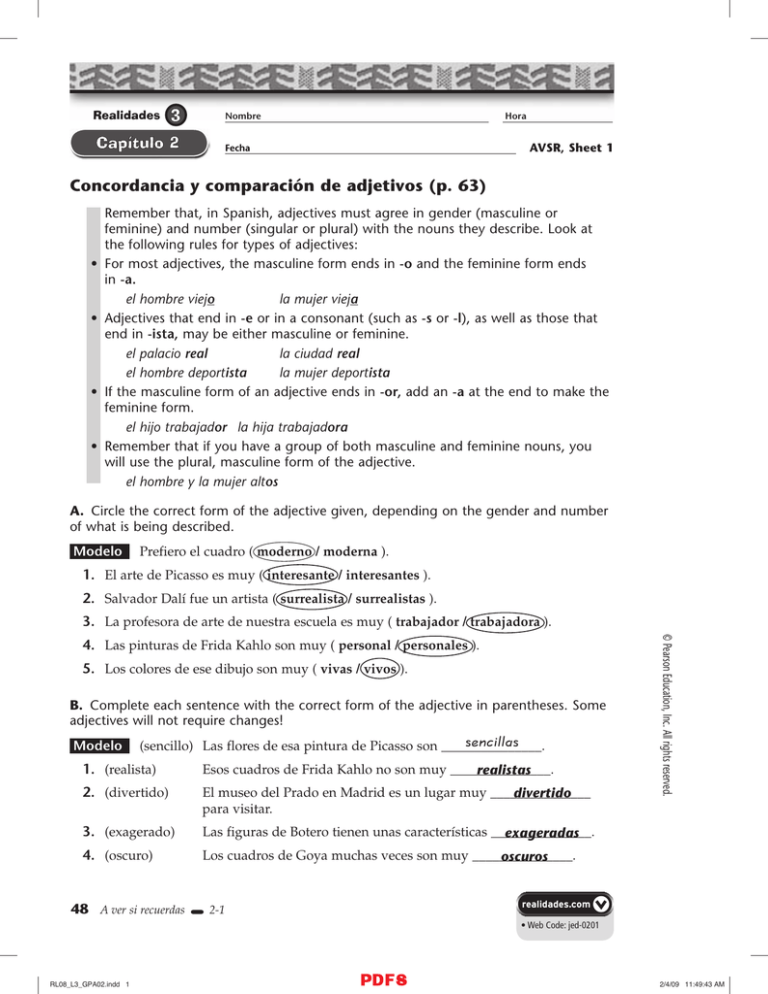
Realidades Nombre Fecha Hora AVSR, Sheet 1 Concordancia y comparación de adjetivos (p. 63) • • • • Remember that, in Spanish, adjectives must agree in gender (masculine or feminine) and number (singular or plural) with the nouns they describe. Look at the following rules for types of adjectives: For most adjectives, the masculine form ends in -o and the feminine form ends in -a. el hombre viejo la mujer vieja Adjectives that end in -e or in a consonant (such as -s or -l), as well as those that end in -ista, may be either masculine or feminine. el palacio real la ciudad real el hombre deportista la mujer deportista If the masculine form of an adjective ends in -or, add an -a at the end to make the feminine form. el hijo trabajador la hija trabajadora Remember that if you have a group of both masculine and feminine nouns, you will use the plural, masculine form of the adjective. el hombre y la mujer altos A. Circle the correct form of the adjective given, depending on the gender and number of what is being described. Modelo: Prefiero el cuadro ( moderno / moderna ). 1. El arte de Picasso es muy ( interesante / interesantes ). 2. Salvador Dalí fue un artista ( surrealista / surrealistas ). 3. La profesora de arte de nuestra escuela es muy ( trabajador / trabajadora ). 5. Los colores de ese dibujo son muy ( vivas / vivos ). B. Complete each sentence with the correct form of the adjective in parentheses. Some adjectives will not require changes! Modelo: sencillas (sencillo) Las flores de esa pintura de Picasso son _______________. 1. (realista) Esos cuadros de Frida Kahlo no son muy _______________. realistas 2. (divertido) El museo del Prado en Madrid es un lugar muy _______________ divertido para visitar. 3. (exagerado) Las figuras de Botero tienen unas características _______________. exageradas 4. (oscuro) Los cuadros de Goya muchas veces son muy _______________. oscuros 48 A ver si recuerdas 2-1 © Pearson Education, Inc. All rights reserved. 4. Las pinturas de Frida Kahlo son muy ( personal / personales ). i\Xc`[X[\j%Zfd • Web Code: jed-0201 RL08_L3_GPA02.indd 1 2/4/09 11:49:43 AM Realidades Nombre Hora AVSR, Sheet 2 1 Fecha • To compare two things that are the same, use tan + adjective + como. Los cuadros de Picasso son tan interesantes como los cuadros de Dalí. • To compare two things that are different, use más / menos + adjective + que. El retrato de Botero es más cómico que el retrato de Velázquez. Remember that the adjective must agree in gender and number with the noun it describes. C. Use the signs provided to complete each of Juan’s opinions using either más…que, menos…que, or tan…como. Then, circle the correct form of the adjective in parentheses based on the corresponding noun. Follow the model. Modelo: ( + ) Creo que el arte de Picasso es ______ que más ( interesantes / interesante ) ______ el arte de Velázquez. 1. ( – ) El color rosado es __________ el color rojo. menos ( vivo / viva ) __________ que 2. ( = ) Creo que los museos son __________ ( divertido / divertidos ) __________ tan como los cines. 3. ( + ) Ese mural de Diego Rivera es __________ ( grande / grandes ) __________ aquel más que retrato de Frida Kahlo. 4. ( = ) El pintor es __________ ( trabajador / trabajadora ) __________ la pintora. tan como 5. ( – ) El papel y el plástico son __________ el oro y la plata. menos ( caros / caro ) __________ que © Pearson Education, Inc. All rights reserved. • With the adjectives bueno(a), malo(a), viejo(a) and joven, you do not use the más or menos + adjective structure. Instead, use one of the following irregular comparative forms: bueno(a) mejor (que) (pl. mejores) better (than) malo(a) peor (que) (pl. peores) worse (than) viejo(a) mayor (que) (pl. mayores) older (than) joven menor (que) (pl. menores) younger (than) D. Use the irregular comparative adjectives to create accurate comparisons. Modelo: Susana tiene 16 años y Martina tiene 18 años. Martina es ________ mayor que Susana. 1. Ana tiene 13 años y Luz tiene 17 años. Ana es _______________ que Luz. menor 2. Pedro saca una “A” en la clase de inglés y Jorge saca una “C.” La nota de Pedro es _______________ que la nota de Jorge. mejor 3. Paco tiene 16 años y su abuelo tiene 83. El abuelo es _______________ que Paco. mayor 4. Los cuadros de Carla no son muy buenos, pero los cuadros de Tomás son excelentes. Los cuadros de Carla son _______________ que los cuadros de Tomás. peores i\Xc`[X[\j%Zfd A ver si recuerdas 2-2 49 • Web Code: jed-0201 RL08_L3_GPA02.indd 49 2/19/09 9:46:10 AM Realidades Nombre Hora AVSR, Sheet 3 1 Fecha Comparación de sustantivos y el superlativo (p. 65) • To make a comparison of quantity between two nouns that are equal in number, use tanto (tanta/tantos/tantas) + noun + como. Be sure to pay attention to gender and number agreement. Hay tantos actores como actrices en la obra de teatro. • To make a comparison of quantity between two nouns that are not equal, use más/menos + noun + que. Hay más actores que músicos en la obra de teatro. Hay menos personas en el teatro que anoche. A. Use menos…que or más…que to create logical sentences. Modelo: más actores ________ que actrices. Hay tres actores y dos actrices. Hay ________ menos 1. Hay dos directores y diez actores. Hay _______________ directores _______________ que actores. más 2. Hay doce personas en el coro y veinte personas en la orquesta. Hay _______________ que personas en la orquesta _______________ en el coro. 3. Este año se van a presentar veinticinco conciertos y diez obras de teatro en el Teatro menos Santiago. Se van a presentar _______________ obras de teatro _______________ que conciertos. 4. La actriz principal tiene mucho talento pero los otros actores no tienen mucho menos que talento. Ellos tienen _______________ talento _______________ la actriz principal. más 5. En la ciudad hay cuatro cines y dos teatros. Hay _______________ cines que _______________ teatros. Modelo: tantas guitarras como Hay dos guitarras y dos pianos en la orquesta. Hay ________ pianos. 1. La actriz principal tiene mucho talento y el actor principal tiene mucho talento. El actor tiene _______________ talento como la actriz. tanto 2. Se presentan dos obras dramáticas y dos obras musicales en el teatro este fin de semana. Se presentan _______________ obras dramáticas como obras musicales. tantas 3. Ayer asistieron doscientas personas a la obra y hoy asisten doscientas. Hoy hay _______________ gente como ayer. tanta © Pearson Education, Inc. All rights reserved. B. Use tanto, tanta, tantos or tantas to complete each sentence. 4. Hay diez músicos y diez bailarines en la obra. Hay _______________ músicos como tantos bailarines. 5. Hoy las entradas cuestan $15 y anoche las entradas costaron $15. Las entradas cuestan _______________ dinero hoy como ayer. tanto 50 A ver si recuerdas 2-3 i\Xc`[X[\j%Zfd • Web Code: jed-0201 RL08_L3_GPA02.indd 3 2/4/09 11:49:48 AM Realidades Nombre Hora AVSR, Sheet 4 Fecha Comparación de sustantivos y el superlativo (continued ) • To say something is the “most” or the “least,” you use a structure called the superlative. To form the superlative, use el/la/los/las + noun + más/menos + adjective. Celia Cruz es la cantante más talentosa. Creo que Roger Ebert es el crítico más inteligente. • To compare one thing within a large group, use de + the group or category. Marta es la más alta de todas las actrices. C. Complete the following superlatives with the missing elements. Follow the model. Modelo: ( + ) La clase de español es la ___________ divertida de mi escuela. más 1. Andrés es el más alto ___________ mi clase de español. de 2. ( + ) El domingo es el día ___________ tranquilo de la semana. más 3. ( + ) Mariana tiene la voz ___________ bella del coro. más 4. ( – ) Ésa es la escena ___________ emocionante del drama. más 5. Las hermanas Cruz son las músicas más talentosas ___________ la escuela. de © Pearson Education, Inc. All rights reserved. • Use the adjectives mejor(es) and peor(es) + noun to express best and worst. Plácido Domingo es el mejor cantante. Esos son los peores efectos especiales. D. Read the description of the following theater, art, and music students. Use the context of the sentence to decide whether to use mejor / mejores or peor / peores. Complete the sentences with your choice. Modelo: Maricarmen tiene una voz muy bonita. Es la _________ mejor cantante del coro. 1. Ramón no puede bailar muy bien. Es el _______________ bailarín del grupo. peor 2. Sonia y Teresa actúan muy bien. Son las _______________ actrices de su escuela. mejores 3. El director de la obra es muy antipático y grita mucho. ¡Es el _______________ peor director del mundo! 4. Nuestra orquesta toca perfectamente. Es la _______________ orquesta de la ciudad. mejor 5. Los argumentos de estas dos obras son muy aburridos. Son los _______________ peores argumentos. i\Xc`[X[\j%Zfd A ver si recuerdas 2-4 51 • Web Code: jed-0201 RL08_L3_GPA02.indd 4 2/4/09 11:49:50 AM Realidades Nombre Hora Guided Practice Activities, Sheet 1 Fecha Pretérito vs. imperfecto (p. 76) • Remember that you have learned two past tenses: the preterite and the imperfect. Look at the information below for a summary of when to use each tense: Preterite • actions that happened once or were completed in the past • to relate a series of events that happened Imperfect • habitual or repeated actions in the past • descriptions such as background information, physical appearance, emotions, time, date, age, and weather When you have two verbs in one sentence, use the following rules: • If two actions were going on simultaneously and did not interrupt each other, put both verbs in the imperfect: Yo leía mientras mi hermana pintaba. • If one action that is in progress in the past is interrupted by another action, put the action in progress in the imperfect and the interrupting action in the preterite: Los estudiantes pintaban cuando su maestro salió de la clase. A. Read each of the following statements about Picasso’s life and career. Then decide if the statement is about something Picasso used to do or if it is something he did once. Place a checkmark in the box of your choice. Modelo: Pablo Ruiz Picasso nació en Málaga el 25 de octubre de 1881. © Pearson Education, Inc. All rights reserved. used to do ✓ did once 1. Hizo un viaje a París en 1900. used to do ✓did once 2. Pasaba mucho tiempo con el artista André Breton y la escritora Gertrude Stein. ✓ used to do did once 3. Hacía cuadros monocromáticos. ✓used to do did once 4. Quería expresar la violencia y la crueldad de la Guerra Civil Española. ✓ used to do did once 5. Pintó el cuadro Guernica para ilustrar los horrores de la guerra. used to do ✓did once i\Xc`[X[\j%Zfd Guided Practice Activities 1 2-1 59 • Web Code: jed-0203 RL08_L3_GPA02.indd 59 2/19/09 9:46:23 AM Realidades Nombre Hora Guided Practice Activities, Sheet 2 Fecha B. Javier recently visited his friend Domingo’s art studio. Read each part of the story and decide if it gives description/background information or if it tells what happened in the story. Circle your choice. Modelo: Eran las tres y hacía buen tiempo. What happened Description 1. Llegué al taller de Domingo a las tres y media. What happened Description 2. Llamé a la puerta, pero nadie contestó. What happened Description 3. La puerta estaba abierta. What happened Description 4. Entré en el taller. What happened Description 5. Encontré a Domingo. What happened Description 6. No tenía ganas de trabajar más. What happened Description C. Choose the correct form of each verb to complete these sentences about an artist. 1. Cuando ( era / fui ) niña, me ( gustaba / gustó ) mucho el arte. 2. Siempre ( tomaba / tomé ) clases de arte y ( dibujaba / dibujé ) en mi tiempo libre. 3. La semana pasada, ( empezaba / empecé ) una pintura nueva. 4. Primero, ( pintaba / pinté ) el fondo con colores oscuros y después, ( incluía / incluí ) unas figuras de animales. D. Complete the following sentences with the preterite or the imperfect form of the verb. empezó (empezar). Eran ____________ (ser) las dos cuando la clase de arte _____________ entró 1. Los estudiantes ya _______________ trabajaban (trabajar) cuando su profesor _______________ (entrar). dijo 2. El profesor les _______________ (decir), «Uds. son muy trabajadores». hizo 3. Luego, el profesor _______________ (hacer) una demostración de una técnica artística nueva. practicaban (practicar), el profesor _______________ 4. Mientras los estudiantes _______________ caminaba (caminar) por la clase para observar sus avances. © Pearson Education, Inc. All rights reserved. Modelo: estaba 5. El profesor _______________ (estar) contento porque sus estudiantes aprendieron (aprender) la técnica muy bien. _______________ 60 Guided Practice Activities 2-2 i\Xc`[X[\j%Zfd • Web Code: jed-0203 RL08_L3_GPA02.indd 13 2/4/09 11:50:08 AM Realidades Nombre Hora Guided Practice Activities, Sheet 3 Fecha Estar + participio (p. 79) • To form the past participle of -ar verbs, add -ado to the root of the verb. For -er and -ir verbs, add -ido to the root. See the examples below. lavar lavado (washed) comer comido (eaten) servir servido (served) A. Write the past participle form for each verb. Follow the model. Modelo: creado (crear) ___________ 1. (inspirar) __________________ inspirado 5. (influir) __________________ influido 2. (vestir) __________________ vestido 6. (pintar) __________________ pintado 3. (representar) __________________ representado 7. (tomar) __________________ tomado 4. (vender) __________________ vendido 8. (mover) __________________ movido • It is common to use the past participle with the verb estar to give descriptions. Remember that since the past participle is being used as an adjective in these cases, it must agree in gender and number with the noun it describes: El pintor está cansado. Las pintoras están cansadas. B. Read the following descriptions of famous paintings. Underline the noun in the sentence. Then, circle which form of the past participle best completes each sentence. Modelo: Las dos chicas están ( sentada / sentadas ). © Pearson Education, Inc. All rights reserved. 1. La ventana del fondo está ( cerrado / cerrada ). 2. El fondo está ( pintado / pintados ) con colores oscuros. 3. Dos gatos están ( dormidos / dormidas ) en el sofá. 4. La cena está ( preparada / preparado ). 5. La pintura está ( basado / basada ) en los sueños del artista. 6. El pintor está ( incluido / incluida ) en la pintura. 7. Unos temas importantes están ( representadas / representados ). i\Xc`[X[\j%Zfd Guided Practice Activities 2-3 61 • Web Code: jed-0205 RL08_L3_GPA02.indd 14 2/4/09 11:50:10 AM Realidades Nombre Hora Guided Practice Activities, Sheet 4 Fecha • Some verbs have irregular past participles. Look at the list below: poner: puesto decir: dicho hacer: hecho escribir: escrito ver: visto abrir: abierto morir: muerto romper: roto volver: vuelto resolver: resuelto C. Read the following description of an artist’s workshop. First, write the past participle of the verb in parentheses. Next, complete the sentences with the correct form of this past participle. Be careful to make its ending match the noun in the sentence in number and gender. Modelo: puesto ) Cuando entré en el taller, las luces no estaban __________. puestas ( poner:__________ abierto ) La ventana estaba ____________ abierta y hacía frío. 1. (abrir:____________ rota roto 2. (romper:____________ ) Una pintura grande estaba ____________ en el suelo. puesto puestos en la mesa. 3. (poner:____________ ) Los pinceles y la paleta estaban ____________ escrito escritas en el 4. (escribir:____________ ) Unas notas para pinturas futuras estaban ____________ cuaderno del artista. hecho hecha 5. (hacer:____________ ) Una escultura de un animal estaba ____________. 6. (morir:____________ ) Un ratón estaba ____________ en el taller. ¡Qué horror! muerto muerto D. The classroom was a mess when the students arrived Monday morning. Use the verbs in parentheses to write a sentence using estar + past participle. Follow the model. Modelo: Las ventanas _______________ _______________ estaban abiertas (abrir). 2. Las paletas _______________ _______________ (poner) en el suelo. estaban puestas 3. Las botellas de agua de la maestra _______________ _______________ (beber). estaban bebidas 4. La computadora _______________ _______________ (romper). estaba rota 5. Los libros de texto _______________ _______________ (perder). estaban perdidos 6. Unos insectos habían entrado por la ventana y _______________ _______________ estaban muertos (morir) en el suelo. 62 Guided Practice Activities 2-4 © Pearson Education, Inc. All rights reserved. 1. Unas palabras _______________ _______________ (escribir) en la pared. estaban escritas i\Xc`[X[\j%Zfd • Web Code: jed-0205 RL08_L3_GPA02.indd 62 3/2/09 12:34:59 PM Realidades Nombre Fecha Hora Guided Practice Activities, Sheet 5 Ser y estar (p. 88) • Remember that Spanish has two verbs that mean “to be”: ser and estar. Look at the rules below to review the circumstances in which each verb should be used: Ser is used . . . • to describe permanent physical and personal characteristics • to describe nationality or origin • to describe someone’s job or profession • to tell where and when an event will take place • to tell whom something belongs to Estar is used . . . • to describe temporary physical conditions or emotions • to give location • as part of the progressive tenses, such as está escuchando or estaba escuchando A. Use es or está to describe the director of a show. El director... 1. nació en Madrid. _________ español. Es 2. trabaja mucho todos los días. _________ muy serio. Es Está contento. 3. cree que los actores están trabajando muy bien esta noche. _________ Es 4. Tiene mucho dinero. _________ rico. © Pearson Education, Inc. All rights reserved. Está 5. Lleva un traje elegante esta noche. _________ muy guapo. 6. _________ músico también. Es B. Complete the paragraph with the appropriate present tense forms of ser or estar. está preparando una presentación de la obra de teatro Romeo y Nuestra escuela _________ Julieta. Romeo y Julieta _________ la historia de dos jóvenes que _________ es están enamorados, son es pero sus familias _________ enemigas. Marta Ramos _________ la actriz principal: interpreta el papel de Julieta. Marta _________ una chica muy talentosa que _________ de es es Puerto Rico. Ella _________ la primera está muy entusiasmada porque este viernes _________ es Es representación de la obra. _________ en el teatro de la escuela a las siete de la noche. Todos están trabajando mucho esta semana para memorizar el guión. Los los actores _________ acontecimientos de las vidas de Romeo y Julieta _________ muy trágicos, pero la obra son es _________ magnífica. i\Xc`[X[\j%Zfd Guided Practice Activities 2-5 71 • Web Code: jed-0207 RL08_L3_GPA02.indd 24 2/4/09 11:50:30 AM Realidades Nombre Hora Guided Practice Activities, Sheet 6 Fecha Ser y estar (continued ) • Sometimes using ser or estar El café es bueno. El café está bueno. El actor es aburrido. El actor está aburrido. La directora es bonita. La directora está bonita. Los actores son ricos. La comida está rica. with the same adjective causes a change in meaning: Coffee is good. (in general). The coffee tastes good. (today). The actor is boring. (in general) The actor is bored. (today) The director is pretty. (in general) The director looks pretty. (today) The actors are rich. (in general) The food is tasty. (today) C. Decide if the following statements refer to what the people in a show are like in general, or if they describe what they are like in today’s show. 1. La cantante... 2. Los actores… a. es bonita. hoy en general a. están elegantes. hoy en general b. está nerviosa. hoy en general b. son ricos. hoy en general c. es cómica. hoy en general c. están contentos. hoy en general d. es colombiana. hoy en general d. son talentosos. hoy en general D. You and a friend are commenting on a variety show. Read each statement and decide which response best states the situation. The first one has been done for you. © Pearson Education, Inc. All rights reserved. 1. La actriz tiene un vestido especialmente bonito esta noche. a. Es guapa. b. Está guapa. 2. Los músicos no tocan mucho y quieren irse. a. Son aburridos. b. Están aburridos. 3. Esos hombres tienen mucho dinero y coches lujosos. a. Son ricos. b. Están ricos. 4. Las cantantes se sienten bien porque cantaron muy bien la canción. a. Son orgullosos. b. Están orgullosas. 5. El camarero nos preparó un café especialmente delicioso esta noche. a. El café es rico. b. El café está rico. 72 Guided Practice Activities 2-6 i\Xc`[X[\j%Zfd • Web Code: jed-0207 RL08_L3_GPA02.indd 25 2/4/09 11:50:33 AM Realidades Nombre Hora Guided Practice Activities, Sheet 7 Fecha Verbos con distinto sentido en el pretérito y en el imperfecto (p. 90) • Some verbs have different meanings in the preterite and the imperfect. Look at the following chart to understand these changes in meaning: Verbo Imperfecto Pretérito saber knew a fact or how to do something found out conocer knew a person or place met for the first time querer wanted to tried to no querer didn’t want to refused to poder could, was able to tried and succeeded in doing A. Choose which idea is being expressed by the underlined verb in each sentence. Modelo: Los estudiantes conocieron al actor famoso. ✓ met knew 1. Jorge quería ser el galán de la obra de teatro. tried to ✔ wanted to 2. Lupe quiso sacar fotos del espectáculo. ✔ tried to wanted to 3. Yo sabía el título del poema. © Pearson Education, Inc. All rights reserved. found out ✔ knew 4. Mi mamá supo que nuestro vecino es artista. ✔ found out knew 5. No quería aprender la melodía de esta canción aburrida. refused to ✔ didn’t want to 6. No quise entrar al teatro. ✔ refused to didn’t want to 7. Pudimos realizar el baile sin problemas. ✔ managed to, succeeded in were able to, could 8. Podíamos identificarnos con el protagonista. managed to, succeeded in i\Xc`[X[\j%Zfd ✔ were able to, could Guided Practice Activities 2-7 73 • Web Code: jed-0209 RL08_L3_GPA02.indd 26 2/4/09 11:50:35 AM Realidades Nombre Hora Guided Practice Activities, Sheet 8 Fecha B. Ana tells the story of how she finally got to meet a famous salsa singer. Complete the following sentences with the correct preterite or imperfect form of the verb in parentheses. Modelo: conocí Yo _______________ (conocer) a Carlos, mi mejor amigo, hace dos años. 1. Hacía muchos años que Carlos _______________ (conocer) a una cantante de salsa. conocía 2. Yo _______________ (saber) bailar salsa y me gustaba ir a los clubes de salsa. sabía 3. Una noche Carlos y yo decidimos ir al club donde trabajaba la cantante pero luego yo _______________ (saber) que tenía que trabajar y no pude ir. supe 4. Carlos _______________ (saber) que yo quería conocer a su amiga y la invitó a mi sabía casa al día siguiente. 5. Yo _______________ (conocer) a la cantante y fue el día más fantástico de mi vida. conocí C. Complete the following sentences with the correct preterite or imperfect yo form of the verb in parentheses. Modelo: Yo _______________ (querer) aprender los pasos de la salsa, pero no sé bailar quise bien y la clase fue un desastre. 1. Yo _______________ (querer) leer en un café. Por eso le pregunté al dueño del café si quería era posible. 2. Yo _______________ (querer) leer la poesía en el café, pero me puse nerviosa y no quise pude terminar el poema. 4. Julia no_______________ (querer) salir con Pepe y por eso él tuvo que ir solo al cine. quiso 5. El director nos dijo que nosotros _______________ podíamos (poder) participar en la obra de teatro. 6. Nosotros no teníamos mucho dinero, pero _______________ (poder) comprar las pudimos entradas porque sólo costaban $5. Las compramos ayer. 74 Guided Practice Activities 2-8 © Pearson Education, Inc. All rights reserved. 3. Julia no _______________ (querer) salir con Pepe, pero salieron porque él es el mejor quería amigo de su novio. i\Xc`[X[\j%Zfd • Web Code: jed-0209 RL08_L3_GPA02.indd 27 2/4/09 11:50:37 AM Realidades Nombre Hora Reading Activities, Sheet 1 Fecha Puente a la cultura (pp. 94–95) A. Look at the paintings by Francisco de Goya on the pages surrounding the article. Check off all words on the following list that could be used to describe one or more of the works you see. ✔ realistas abstractos ✔ retratos ✔ surrealistas ✔ oscuros monocromáticos © Pearson Education, Inc. All rights reserved. B. This reading contains many cognates, or Spanish words that look and sound like English words. Can you determine the meanings of the following words? Circle the option that you think represents the correct meaning. 1. la corte a. curtain b. court 2. los triunfos a. triumphs b. trumpets 3. la época a. epoch, age b. epicenter 4. las tropas a. traps b. troops 5. las imágenes a. imaginations b. images 6. los monstruos a. monsters b. monsoons C. This reading talks about four important events in Goya’s life and how each event affected the art he created. Match each event with the painting or type of paintings it led Goya to produce. c Se enfermó 1. _____ a. El 3 de mayo de 1808 d Llegó a ser Pintor de la Cámara 2. _____ b. bocetos (sketches) de la vida diaria en Madrid a Hubo una guerra entre España y Francia 3. _____ b Trabajó para la Real Fábrica de Tapices 4. _____ i\Xc`[X[\j%Zfd c. las “Pinturas negras” d. retratos de los reyes y la familia real Reading Activities 2-1 75 • Web Code: jed-0210 RL08_L3_GPA02.indd 28 2/4/09 11:50:39 AM Realidades Nombre Hora Reading Activities, Sheet 2 Fecha Lectura (pp. 100-103) A. The reading in your book, Cuando era puertorriqueña, is an excerpt from an autobiography. From what you know of autobiographies, check off the items you might find in this reading. ✔ important events in one’s life ✔ first person narration talking animals ✔ real-world settings analysis of scientific data B. Read the following excerpt from the story. Based on what you read, write the letter of the teacher who would most likely discuss each topic below with his or her students. —Mister Gatti, el maestro de gramática, te dirigirá . . . Y Missis Johnson te hablará acerca de lo que te debes de poner y esas cosas. b la ropa 1. ____ a. Mr. Gatti a la pronunciación 2. ____ b. Mrs. Johnson a la fonética 3. ____ a el inglés 4. ____ 1. Esmeralda quería salir muy bien en su audición porque ( quería salir de Brooklyn / quería ser una actriz famosa ). 2. Cuando Esmeralda se enfrentó con el jurado ( se le salió un inglés natural / se le olvidó el inglés ). 3. Antes de presentar su soliloquio, Esmeralda estaba ( tranquila / nerviosa ). 4. Cuando presentó su soliloquio, ( habló con mucha expresión / habló muy rápido ). © Pearson Education, Inc. All rights reserved. C. The girl in the story, Esmeralda, has her first audition to get into the Performing Arts High School. Circle the best choice below to complete the statements about the events leading up to and including the audition. 5. Las mujeres del jurado sabían que Esmeralda ( estaba nerviosa / tenía talento ). 76 Reading Activities RL08_L3_GPA02.indd 29 2-2 2/4/09 11:50:41 AM Realidades Nombre Hora Fecha D. Now, read the statements about the events following the audition, and circle whether they are true (cierto) or false (falso). 1. La mamá de Esmeralda fue con ella a la audición. cierto falso 2. Esmeralda tuvo la oportunidad de pronunciar su soliloquio una segunda vez. cierto falso 3. Bonnie y Esmeralda hicieron el papel de hermanas. cierto falso 4. En la segunda actuación, Esmeralda imaginó que estaba decorando un árbol de Navidad. cierto falso 5. Esmeralda no fue admitida a la Performing Arts High School. cierto falso E. The end of this autobiography occurs years after the audition of Esmeralda, although it recalls the events as if they had just happened. Read the excerpt and answer the questions that follow. Me dijo que el jurado tuvo que pedirme que esperara afuera para poderse reír, ya que les parecía tan cómico ver a aquella chica puertorriqueña de catorce años chapurreando (babbling) un soliloquio acerca de una suegra posesiva durante el cambio de siglo, las palabras incomprensibles porque pasaban tan rápidas. 1. Why, does it turn out, that the jury panel asked Esmeralda to wait outside? ___________________________________________________________________________ The jury panel asked Esmeralda to wait outside because they needed to laugh. © Pearson Education, Inc. All rights reserved. 2. What did the jury find funny about Esmeralda? They found it funny that a young girl was babbling about a possessive ___________________________________________________________________________ mother-in-law during the turn of the century, and that she was hard to ___________________________________________________________________________ understand because she was speaking so fast. Reading Activities RL08_L3_GPA02.indd 30 2-3 77 2/4/09 11:50:43 AM
